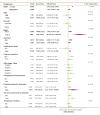Association of blood urea nitrogen to glucose ratio with 365-day mortality in critically ill patients with chronic kidney disease: a retrospective study
- PMID: 40000743
- PMCID: PMC11862077
- DOI: 10.1038/s41598-025-91012-0
Association of blood urea nitrogen to glucose ratio with 365-day mortality in critically ill patients with chronic kidney disease: a retrospective study
Abstract
Low blood glucose levels and high urea nitrogen levels affect patient prognosis, but few studies have investigated whether the blood urea nitrogen to glucose (BGR) ratio predicts the risk of death.This retrospective research examined the connection between the BGR and 365-day mortality in patients with chronic kidney disease (CKD) stages 1-4 admitted to an intensive care unit (ICU). The study utilized data from 6,380 patients in the Medical Information Mart for Intensive Care IV version 2.2 (MIMIC-IV v2.2), taking into account confounding factors such as demographics, vital signs, laboratory indicators, and comorbidities. The study employed both univariate and multivariate Cox regression analyses stratified by BGR quartiles. Additionally, restricted cubic spline regression and inflection point analysis were used to explore the linear relationship between BGR and 365-day mortality, while Kaplan-Meier curve analysis was used to observe mortality changes under different BGR stratifications. Subgroup and mediating effect analyses were performed to evaluate the robustness of BGR's effect on 365-day mortality. The study found a cumulative 365-day mortality rate of 34.2% among CKD stages 1-4 patients, with a 2.43-fold increase in the risk of death associated with BGR and at least a 44% increase in the risk of death for each unit increase in BGR (P = 0.022). A significant nonlinear relationship was identified, showing a stepwise change in the risk of death with a marked increase in the slope of the curve for BGR values below 0.52 and above 0.9 (P < 0.001). Subgroup analyses indicated interactions between BGR and factors such as age, sepsis, first-day antibiotic use, and cerebrovascular disease (P < 0.05). In conclusion, this study confirms that BGR is a significant and stable predictor of 1-year mortality risk in patients with CKD stages 1-4. Interventions aimed at timely adjustment, correction of metabolic imbalances, reduction of inflammation, and management of BGR levels are beneficial for reducing mortality in this patient population.
Keywords: Blood Urea nitrogen to glucose ratio; Chronic kidney disease; Intensive care unit; Medical information Mart for intensive care IV; Mortality.
© 2025. The Author(s).
Conflict of interest statement
Declarations. Competing interests: The authors declare no competing interests.
Figures



Similar articles
-
J-shaped association between blood urea nitrogen-to-creatinine ratio and mortality in critically ill patients with acute pancreatitis: a retrospective cohort study using the MIMIC-IV database.Eur J Med Res. 2025 Mar 19;30(1):185. doi: 10.1186/s40001-025-02430-9. Eur J Med Res. 2025. PMID: 40108699 Free PMC article.
-
A retrospective study utilized MIMIC-IV database to explore the potential association between triglyceride-glucose index and mortality in critically ill patients with sepsis.Sci Rep. 2024 Oct 15;14(1):24081. doi: 10.1038/s41598-024-75050-8. Sci Rep. 2024. PMID: 39402158 Free PMC article.
-
Association between the blood urea nitrogen to serum albumin ratio and the risk of mortality in patients with chronic kidney disease: a cohort study.BMC Nephrol. 2025 Jun 3;26(1):275. doi: 10.1186/s12882-025-04214-z. BMC Nephrol. 2025. PMID: 40462012 Free PMC article.
-
The correlation study between blood urea nitrogen to serum albumin ratio and prognosis of patients with sepsis during hospitalization.BMC Anesthesiol. 2022 Dec 28;22(1):404. doi: 10.1186/s12871-022-01947-4. BMC Anesthesiol. 2022. PMID: 36577937 Free PMC article.
-
Predictive value of stress hyperglycemia ratio on one-year mortality in chronic kidney disease patients admitted to intensive care unit.BMC Nephrol. 2024 Oct 17;25(1):358. doi: 10.1186/s12882-024-03823-4. BMC Nephrol. 2024. PMID: 39420295 Free PMC article.
References
-
- Chen, C. Y. et al. Clinical factors in predicting acute renal failure caused by rhabdomyolysis in the ED. Am. J. Emerg. Med.31, 1062–1066 (2013). - PubMed
-
- Perianayagam, M. C., Seabra, V. F., Tighiouart, H., Liangos, O. & Jaber, B. L. Serum Cystatin C for prediction of Dialysis requirement or death in acute kidney injury: A comparative study. Am. J. Kidney Dis.54, 1025–1033 (2009). - PubMed
MeSH terms
Substances
Grants and funding
LinkOut - more resources
Full Text Sources
Medical

